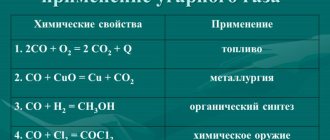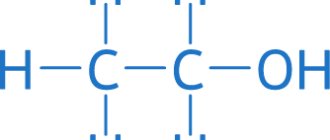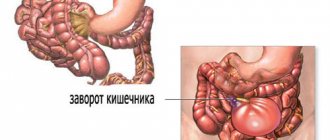Types of poisoning
Depending on the routes through which the poison enters the human body, scientists distinguish:
Inhalation poisoning
With this method of poisoning, toxic substances enter the bronchi and lungs with inhaled air.
Inhalation drugs include:
- poisoning by vapors of acids and alkalis;
- carbon monoxide poisoning;
- ammonia poisoning;
- household gas poisoning;
- chlorine poisoning;
- mercury vapor poisoning.
Similar poisonings are possible at chemical industry enterprises, metallurgy and other industries. Providing first aid in case of gas poisoning or toxic fumes at work, when there are many victims, is carried out in special protective equipment.
In everyday life, people more often suffer from carbon monoxide or natural gas leaks. First aid for carbon monoxide poisoning is to take the victim to fresh air!
Contact poisoning
In this case, toxins enter the body through the skin or mucous membranes.
Contact poisonings include:
- pesticide poisoning;
- fluoride salt poisoning;
- benzene poisoning;
- petroleum product poisoning;
- formaldehyde poisoning.
First aid for poisoning is as follows: the victim should be immediately removed from the area affected by the toxic substance, remove his clothes, remove the poison from the skin with a cloth or cotton wool, and wash the toxic substance from the skin with running water and soap.
Poisoning due to an insect, animal or snake bite
The poison enters through a skin defect (bite, wound). The first thing to do in case of poisoning at home is to place an ice pack on the bite site; if a limb has been damaged by the bite, then a venous tourniquet is applied above the bite site to reduce the spread of poison through the bloodstream.
Oral poisoning (by mouth)
Such poisonings include:
- food poisoning;
- alcohol poisoning;
- drug poisoning;
- mushroom poisoning;
- chemical poisoning.
First aid for poisoning should be started at the first signs of intoxication.
Gastric lavage and siphon enema are performed. If the patient is unconscious, in case of poisoning with caustic substances, lavage is carried out through a gastric tube.
The most common cases are household poisoning, food poisoning, alcohol poisoning and mushroom poisoning. The nervous, respiratory and digestive systems of the body are most affected by the effects of the toxic substance. Providing first aid for poisoning is aimed at stopping the effects of poison on the body.
The main condition for first aid in case of poisoning is emergency hospitalization in intensive care or toxicology departments, where antidote therapy and artificial detoxification are possible.
Sources
- Pellegrino JL., Krob JL., Orkin A. First Aid Education for Opioid Overdose Poisoning: Scoping Review. // Cureus - 2021 - Vol13 - N1 - p.e12454; PMID:33552772
- Borra V., Avau B., De Paepe P., Vandekerckhove P., De Buck E. Is placing a victim in the left lateral decubitus position an effective first aid intervention for acute oral poisoning? A systematic review. // Clin Toxicol (Phila) - 2021 - Vol57 - N7 - p.603-616; PMID:30784327
- Avau B., Borra V., Vanhove AC., Vandekerckhove P., De Paepe P., De Buck E. First aid interventions by laypeople for acute oral poisoning. // Cochrane Database Syst Rev - 2021 - Vol12 - NNULL - p.CD013230; PMID:30565220
- Yue Y., Pan X., Zhang S., Jin J., Wang W., Wang D., Han D., Wang G., Hu Q., Kang J., Ding S., Yang Y., Bu H ., Guo Y. A Randomized Controlled Trial of Puncturing and Bloodletting at Twelve Hand Jing Points to Treat Acute Carbon Monoxide Poisoning as Adjunct to First Aid Treatment: A Study Protocol. // Evid Based Complement Alternat Med - 2015 - Vol2015 - NNULL - p.827305; PMID:26339271
- Goktas S., Yildirim G., Kose S., Yildirim S., Ozhan F., Senturan L. First Aid Knowledge of University Students in Poisoning Cases. // Turk J Emerg Med - 2014 - Vol14 - N4 - p.153-9; PMID:27437513
First aid for food poisoning
In case of food poisoning, the “culprits” are most often foods contaminated with pathogenic microbes or containing microbial toxins. The source of infection can also be water contaminated with bacteria.
Symptoms of poisoning develop quite quickly - from half an hour to several hours after eating.
What to do in case of poisoning?
It is necessary to clear the stomach of the toxic substance as soon as possible. This can be done before the ambulance arrives, by washing the stomach with 1-2 liters of boiled water or a weak solution of potassium permanganate, and giving an anti-poisoning gel - Enterosgel.
In case of diarrhea, it is necessary to replenish fluid loss by giving the patient unsweetened tea and salted water.
First aid if a child is poisoned by poor quality food can be provided by parents.
What can be done:
- Rinse the stomach;
- Provide plenty of fluids;
- Give Enterosgel sorbent (safe and recommended from the first days of life);
- Call a doctor.
First aid for poisoning in adults also involves taking Enterosgel sorbent, which effectively absorbs toxins in the intestines. In the absence of diarrhea, the doctor prescribes an enema or the patient is given a saline laxative to remove the toxic substance from the intestines, and detoxification therapy is prescribed.
What it is
Hydrogen sulfide is the simplest compound of sulfur and hydrogen atoms. It has other names - hydrogen sulfide, hydrogen disulfide. It is a gaseous substance with a peculiar unpleasant odor of rotten eggs. It is highly flammable; in high concentrations it is explosive when combined with oxygen. It dissolves well in alcohol, but the process is worse in water.
It is produced in a minimal amount in the human body during the rotting of food residues in the intestines. Affects the transmission of nerve impulses.
Hydrogen sulfide is found in nature, industrial and mining sectors, and chemical activities. The compound often forms as a result of the decomposition of rocks and sulfide minerals. Due to some of its properties it is used in medicine.
At minimal concentrations it is not capable of causing serious harm to the body. The mechanism of action is such that hydrogen sulfide can disrupt a person’s sense of smell. After some time, he ceases to feel the unpleasant odor, the result is severe intoxication with negative consequences.
Alcohol poisoning
The first first aid for alcohol poisoning is gastric lavage. Thanks to this simple procedure, you can remove drunk alcohol and reduce its absorption in the stomach, thereby reducing alcohol intoxication. After cleansing the stomach of the remnants of “strong” drinks, you need to give the victim Enterosgel sorbent and place him under a blanket.
If a person is unconscious, it is necessary to urgently call an ambulance and lay him on his side - this will reduce the likelihood of vomit getting into the upper respiratory tract.
First aid for alcohol poisoning in a hospital setting involves detoxification therapy, restoring the functioning of vital organs and systems. In a good way, everyone should know what the symptoms of alcohol poisoning look like and what to do if they are detected.
First aid for mushroom poisoning
Inexperienced mushroom pickers often become victims of toadstool poisoning. Mushroom poison causes damage to the central nervous system, liver and kidneys. Therefore, first aid for poisoning with poisonous mushrooms should be provided by doctors!
How can you help a person before the doctor arrives?
After you have called an ambulance, first aid for mushroom poisoning at home consists of gastric lavage. It should be rinsed until the rinsing waters become clear. After this, you can give the victim Enterosgel sorbent.
First aid for carbon monoxide poisoning
Gas poisoning (CO) is a severe intoxication of the body, which can lead to severe damage to internal organs. According to statistics, carbon monoxide poisoning occupies a leading position among the causes of death from acute poisoning, so it should be taken extremely seriously.
Symptoms of carbon monoxide poisoning:
- Headache;
- Drowsiness;
- Chest pain;
- Redness of the skin;
- Hallucinations;
- Dry cough;
Severe gas poisoning is accompanied by loss of consciousness.
It is important to recognize these symptoms in time and start treatment at home in a timely manner!
Providing first aid for carbon monoxide poisoning
First of all, you need to take the victim out of the contaminated room into fresh air and free him from restrictive clothing. To reduce intoxication, give him Enterosgel sorbent and urgently call an ambulance.
First aid for carbon monoxide poisoning is the antidote - acizole. It is recommended to administer the drug as early as possible in case of poisoning of any severity.
What could be the consequences?
The negative consequences of hydrogen sulfide intoxication are extremely varied - from pulmonary edema to thyroid diseases.
The most common complications include:
- Bronchitis;
- Laryngotracheitis;
- Pneumonia, pulmonary edema;
- Conjunctivitis;
- Polyneuropathy;
- Encephalopathy;
- Pathology of the thyroid gland;
- Dermatitis, skin rashes;
- Kidney failure;
- Deterioration of vision up to complete blindness;
- Burn shock;
- Coronary heart disease, heart failure.
Chlorine poisoning
The cause of poisoning with chlorine and its compounds can be violations of safety regulations in chemical laboratories or industrial accidents when containers with chlorine are damaged.
What symptoms of poisoning with chlorine-containing substances may bother the victim? First of all, this is swelling of the eyelids, oral mucosa, respiratory tract, shortness of breath, pain in the eyes, suffocation.
Timely first aid for chlorine poisoning can prevent a terrible complication - pulmonary edema!
What needs to be done? Remove the victim from the room saturated with chlorine vapors, remove clothing soaked in poison, wash exposed and damaged skin with soap and water, wash eyes and rinse mouth. After this, you should give the poisoned person the Enterosgel sorbent and call an ambulance.
Prevention
To protect yourself from hydrogen disulfide poisoning, you should:
- Be careful when coming into contact with gas in an industrial environment and strictly follow safety regulations;
- When working with hydrogen sulfide, wear a respirator, protective gloves, suit, and goggles;
- Monitor regular ventilation of production premises and proper operation of the hood;
- Timely undergo regular medical examinations to identify hidden symptoms of chronic hydrogen sulfide intoxication.
The severity of hydrogen sulfide poisoning and its consequences depend not only on the concentration of the toxin in the air, but also on the timeliness of emergency care. When carrying out the necessary activities, remember about your own safety - do not enter a room filled with gas without a respirator or gas mask.
First aid for drug poisoning
Drug poisoning can be accidental or intentional. Poisoning in young children occurs due to the fault of adults - tablets are sometimes in a place accessible to children. In case of poisoning at home, it is advisable to find out before the doctor arrives the medicine that the victim took and induce vomiting, then rinse the stomach with warm water and give Enterosgel sorbent.
Providing first aid will help avoid disorders of the cardiac, respiratory and nervous systems.
In a hospital setting, treatment with antidotes, control of intoxication and other resuscitation techniques are carried out to restore the function of internal organs.
First aid for poisoning with acids and alkalis
It is important to remember that in case of poisoning with alkalis and acids that enter through the mouth, it is under no circumstances recommended to rinse the stomach ! The mucous membrane of the digestive tract is covered in numerous chemical burns, and washing can cause gastrointestinal bleeding or perforation of the organ wall.
Toxicologists know which specific antidote to use for poisoning with alkalis and acids, as well as how to provide first aid for poisoning with chemicals, so if a toxic substance gets inside, immediately call an ambulance!
First aid for poisoning by acid vapors and other volatile substances
Inhalation poisoning, which occurs as a result of inhaling vapors of toxic substances, is considered one of the most severe types of intoxication. From the lungs, the poison quickly penetrates the blood and spreads throughout the body. Therefore, it is important to provide first aid in case of poisoning with gas and toxic vapors of chemicals. The victim must immediately be taken out into fresh air, loosen tight clothing, rinse his mouth with water or a soda solution and call an ambulance.
If a person is unconscious, it is necessary to provide the victim with a flow of fresh air, lay him down with his head elevated and wait for the doctor to arrive.
Hydrogen sulfide in forensic medicine
Hydrogen sulfide poisoning occurs in the nature of accidents. When autopsying the corpses of the dead, a picture of death from asphyxia is noted (dark red liquid blood, venous congestion of organs, pulmonary edema and emphysema, pinpoint hemorrhages on the mucous membranes and under the serous membranes; blood and internal organs due to anoxia may have a cherry red color), from cavities and organs - the smell of rotten eggs, this smell is especially noticeable from the lungs.
For with ud.-chem. detection of S. with a short duration of the post-mortem period, the organs are placed in a flask and closed with a stopper with pieces of paper attached, one of which is moistened with a solution of lead acetate, the other with a solution of red litmus or copper sulfate (to prove the absence of ammonia and the decay process) . The rapid blackening of a piece of paper with lead acetate can serve as a preliminary estimate of the amount of hydrogen sulfide (a lot, a little, traces). For qualitative detection of S., indicator papers moistened with a diluted solution of sodium nitroprusside, alkalized with ammonia, can be used. If S. is present, such pieces of paper are painted purple-pink.
Bibliography:
Harmful substances in industry, ed. N.V. Lazarev and I.D. Gadaskina, vol. 3, p. 50, L., 1977; Peregud E. A. Sanitary and chemical control of the air environment, p. 124 and others, L., 1978; Occupational diseases, ed. A. A. Letaveta et al., p. 229, M., 1973; Rem and G. Course of inorganic chemistry, trans. with German, vol. 1, p. 701, M., 1972; Guide to forensic medical examination of poisonings, ed. R.V. Berezhny et al., p. 144, M., 1980; Handbook of diagnosis and treatment of acute occupational intoxications, ed. G. I. Evtushenko and K. G. Abramovich, p. 154, Kyiv, 1966; Handbook of Occupational Pathology, ed. L. N. Gratsianskaya and V. E. Kovshilo, p. 287, L., 1981; Shvaikova M. D. Toxicological chemistry, p. 369, M., 1975; Shekhtman B. A., Samedov I. G. and Mukhametova G. M. Occupational hygiene in the oil industry, p. 180, M., 1979; Bittersohl G. Beitrag zum toxischen Wirkungsmeehanis-mus von Schwefelwasserstoff, Z. ges. Hyg., Bd 17, S. 305, 1971; Tomaszews-ka Z. Smiertelne zbiorowe zatrucie siar-kowodorem, Arch. Med. sad., t. 28, s. 55, 1978.
E. 3. Bronstein (judge), L. M. Karamova (gig.), A. I. Tochilkin (chem.).
First aid for ammonia poisoning
Inhalation poisoning can occur during an industrial accident. In such an emergency, first aid for ammonia poisoning includes the following measures:
- Immediately remove victims from the contaminated area;
- Provide access to clean air;
- Allow the victim to rinse the mouth, throat, and nose with water;
- Rinse the skin on which the toxic substance has come into contact with running water;
- Rinse the stomach;
- Call an ambulance and the rescue service.










